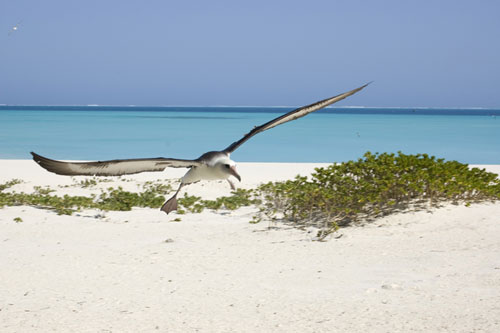Elizabeth Phillips of Moss Landing Marine Laboratories in California, USA and colleagues writing recently in the open-access journal Marine Ornithology have analysed the seabirds killed by experimental demersal longlines in the Bering Sea. Only one individual of an ACAP-listed species (a Laysan Albatross Phoebastria immutabilis) was identified among 417 carcasses.
The paper's abstract follows:
"The seasonal and spatial demographics are summarized for seabirds killed incidentally during gear modification trials for a demersal longline fishery in the Bering Sea. We examined 417 carcasses, including Northern Fulmar Fulmarus glacialis (n = 205), Glaucous-winged Gull Larus glaucescens (n = 103), Short-tailed Shearwater Puffinus tenuirostris (n = 48), Glaucous Gull Larus hyperboreus (n = 23), Slaty-backed Gull Larus schistisagus (n = 4), Black-legged Kittiwake Rissa tridactyla (n = 1), Laysan Albatross Diomedea immutabilis (n = 1), and unidentified gull species Larus spp. (n = 32). There was a significant male bias in the sex ratio of fulmars but not of gulls or shearwaters. For the top three species killed, the age composition of resident species was dominated numerically by adults (Northern Fulmar-86%; Glaucous-winged Gull-63%), whereas migrant species were primarily immature birds (Short-tailed Shearwater-71%). The majority of migratory Short-tailed Shearwaters (88%) were caught in July and August, whereas 70% of resident fulmars and gulls were caught in October and November. Age-class frequencies did not differ by month of capture, indicating that adult mortality is substantial. Eighty percent of the fulmars caught during July and August were within 200 km of two colonies in the Bering Sea, whereas only 7% of fulmars were caught in the same area during September to November. This is one of the first demographic summaries of seabird bycatch in Alaska longline fisheries. Additional studies of the species, age and sex of seabirds subject to fisheries-related mortality will provide data necessary to evaluate population-level impacts."

Reference:
Phillips, E.M., Nevins, H.M., Hatch, S.A., Ramey, A.M., Miller, M.A. & Harvey, J.T. 2010. Seabird bycatch in Alaska demersal longline fishery trials: a demographic summary. Marine Ornithology 38: 111-117.
For a related paper not referenced in the above publication see:
Cooper, J., E. Dunn, E., Kulka, D.W., Morgan, K.H. & Rivera, K.S. 2000. Addressing the problem: seabird mortality from longline fisheries in the waters of Arctic countries. In: Chardine, J.W., Porter, J.M. & Wohl, K.D. (Eds). Workshop on Seabird Incidental Catch in the Waters of Arctic Countries 26-28 April 2000 Report and Recommendations. CAFF Technical Report No. 7. pp. 9, 33-42, 61-65.
John Cooper, ACAP Information Officer, 15 March 2011

 English
English  Français
Français  Español
Español